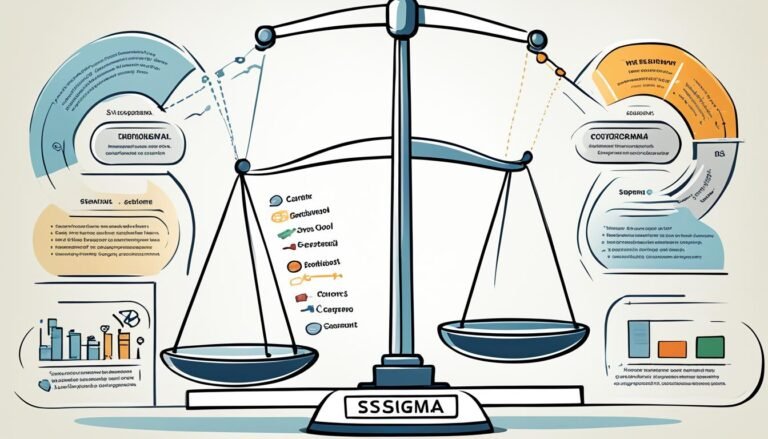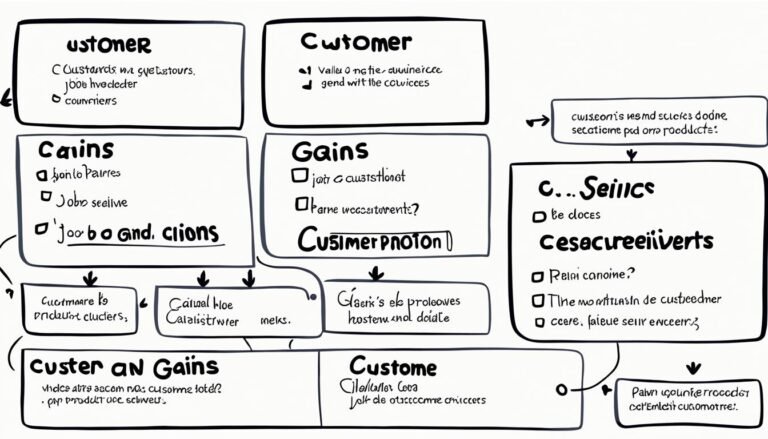The Importance of Strategic Planning – Long-term vs. Short-term Goals
Did you know that having a solid strategic plan can make a business over 50% more likely to hit its long-term goals? This fact shows how crucial strategic planning is for success. It’s key to have a plan that covers both long-term strategy and short-term goals.
When making strategic decisions, it’s important to set clear goals and know how to reach them. This is crucial for growing over time. A good strategic plan helps use resources well, encourages innovation, and sets the stage for lasting success. When a company shares its strategic vision with its team, it often sees better productivity and everyone working together better.
Without a strategic plan, a business might lose focus, waste resources, and miss chances to grow. A good planning process makes goals clear and helps adapt to new situations. Let’s explore more about strategic planning and how it helps with long-term and short-term goals.
Key Takeaways
- Strategic planning significantly increases the likelihood of achieving long-term objectives.
- A comprehensive business plan acts as a roadmap for success and growth.
- Setting concrete, measurable goals enhances the chances of desired outcomes.
- Communicating plans fosters alignment and productivity within the workforce.
- Regular evaluations of performance help adjust strategies for continuous improvement.
- Effective strategic planning enables optimal resource allocation and risk management.
Understanding Strategic Planning
Strategic planning is key for any business. It helps set long-term goals and makes sure resources are used well. This process has steps that give a clear direction for businesses in a changing world. Knowing the benefits of strategic planning helps make the business clear and focused, leading to success.
Definition and Significance
Strategic planning is about deciding on the direction of a business. It matches with the vision and mission and sets clear goals for each department. This process is important because it makes sure everyone in the business works towards the same goals. It also helps create a strategy that deals with outside factors and gets the business ready for the future.
Elements of Strategic Planning
There are important parts to strategic planning:
- Mission Statements: These tell what the organization is all about.
- Environmental Assessments: A deep look at what affects the business from inside and outside.
- Stakeholder Engagement: Getting different people, like employees and shareholders, involved to share ideas and work together.
- Structured Goal-Setting Processes: Setting clear goals that can be tracked and measured.
Good strategic planning does more than just set actions for now. It also gets businesses ready for the future. It’s very important as companies try to predict their future and stay flexible in changing markets.
What Are Long-term Goals?
Long-term goals are key to strategic planning. They help companies plan for the future, tackling challenges and seizing opportunities. These goals cover a period of three to ten years. They aim for sustainable growth and success.
Characteristics of Long-term Goals
Long-term goals have some key features:
- Broad and Ambitious: These goals set big aspirations for organizations.
- Strategic Alignment: They match the company’s overall vision, guiding the planning.
- Comprehensive Planning: Reaching these goals needs detailed planning and ongoing checks.
Examples of Long-term Goals in Business
Businesses can set long-term goals to improve their market position and skills:
- Entering new markets to grow revenue.
- Increasing market share with competitive strategies.
- Creating a pioneering product line that leads trends.
By focusing on long-term strategy, businesses get ready for future goals. This helps them stay strong against market changes. It’s crucial, as 50% of small businesses fail in five years for lacking in planning.
What Are Short-term Goals?
Short-term goals are key steps towards bigger goals. They are set for less than a year and guide actions and decisions. These goals keep everyone focused on the big picture.
Characteristics of Short-term Goals
Short-term goals stand out for several reasons:
- Achievable: They are realistic targets that teams can reach quickly, boosting motivation and morale.
- Specific Focus: These goals are clear, helping employees see how they help the company’s goals.
- Measurable: They can be tracked, letting teams celebrate wins and stay motivated.
- Time-bound: Deadlines create a sense of urgency and prompt action.
Examples of Short-term Goals in Business
Short-term goals greatly impact strategic planning in a company. Here are some examples:
- A sales team might aim for $500,000 in new sales over the year, with quarterly targets like $50,000 in Q1.
- Launching a marketing campaign to get a certain number of leads in a quarter.
- Getting a set number of new clients by the end of the first half of the year.
Short-term goals are crucial in linking daily tasks with big goals. They create a culture of progress and accountability. By setting clear short-term goals, companies keep their teams focused on long-term success.
Difference Between Long-term and Short-term Goals
Understanding the difference between long-term and short-term goals is key to a good Strategic Thinking Approach. Each type of goal plays a unique role in strategic planning. Long-term goals need patience and a big vision of success. Short-term goals are important for keeping teams motivated and on track.
Time Frame Considerations
Long-term goals can take five to ten years or more to reach. They require a high-level strategic planning mindset. They align with the organization’s big vision.
Short-term goals, however, have a shorter timeline, aiming for goals that can be done in weeks or months. Using SMART goals helps both strategies work together. This ensures immediate needs meet future goals.
Flexibility and Adjustability
Short-term goals are clear and focused on the near future. They tackle urgent issues, like customer complaints or improving efficiency. Long-term goals, though, need a detailed plan that looks at many factors, including market trends and challenges.
This requires flexibility, letting businesses change their long-term goals as needed. Regularly checking and adjusting both types of goals helps keep performance strong and adaptable in strategic planning.
Strategic Planning Process
For organizations, strategic planning is key to setting a long-term direction and reaching goals. It starts by understanding the current business scene, which helps in making big decisions. A team forms to look at the company’s strategy and setting, using tools like SWOT analysis to spot strengths, weaknesses, opportunities, and threats. This helps set clear goals.
Steps to Develop a Strategic Plan
Organizations follow several steps in strategic planning. First, they do deep research and listen to customers and employees. Then, they set long-term goals and short-term tasks to move forward. Using Key Performance Indicators (KPIs) helps track success and keep everyone working towards the same goals.
Tools for Effective Strategic Planning
Choosing the right tools makes strategic planning better. Tools like the balanced scorecard give a full view of how well the organization is doing. Project management software helps put these plans into action, making it easier to keep track and make changes as needed. With these tools, including SWOT analysis, companies can use their resources well and succeed over time.
Source Links
- The Importance of Strategic Planning
- Unlock Success: The Remarkable Benefits of Long-Term Planning
- Strategic Planning: How To Set Long And Short-Term Goals? – INVO Blog
- Strategic Planning: Why It Makes a Difference, and How to Do It
- How can you balance short-term and long-term goals in strategic planning?
- THE IMPORTANCE OF BOTH SHORT-TERM AND LONG-TERM STRATEGIC GOALS – MarshBerry
- Long-Term vs Short-Term Planning: Key Differences and Strategies
- Short-Term vs Long-Term Goals (Examples, FAQs) | ClickUp
- The Importance of Short-Term Goals (with examples) [2024] • Asana
- Balancing Short-Term and Long-Term Goals in Corporate Strategy
- Short-Term and Long-Term Goals Examples: A Goal-Setting Guide | Together Mentoring Software
- The Difference Between Short-Term and Long-Term Goal Planning | BoardEffect
- The Differences Between Long-Term and Short-Term Planning
- What is Strategic Planning & Why is it Important?
- Strategic Planning: 5 Planning Steps, Process Guide [2024] • Asana







